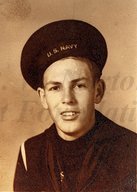
|

|
|
|
|
He was born in Kosciusko, Mississippi, as one of seven children in a sharecropper family. After his father, William Cleveland McDonald, died in 1933, his mother, Annie Sue Loftin McDonald, raised the family. "My mother had to raise seven children by herself with little or no education," he recalls. "We had no money, no nothing. We borrowed, then at the end of the year, you sell whatever you got and any profits left, you get it back. It was a very tough life growing up." Sam worked on a plantation, and plowed behind a mule. "I was in the Navy before I ever knew a mule had two eyes!" he quips. He also learned household chores. His mother taught both sons and daughters how to iron, launder clothes, and cook. Sam attended high school in McCool, Mississippi, graduated in 1943, and entered the U.S. Navy that October. He began boot camp at Great Lakes Naval Training Center on January 4, 1944. He describes that winter training as "fast and cold," and was abbreviated because men were needed in the Pacific. He shipped out on the General George S. Squire on a twenty-eight-day voyage. In Milne Bay, New Guinea he reported to Motor Torpedo Squadron Base Number Four, a base for PT boats, and was assigned to a supply warehouse. Sam helped set up a base on Mindoro in the Philippines, and then returned to America in December of 1945. He was placed in medical quarantine for observation of tropical diseases. Later, he finished his service aboard an escort carrier, Prince William. "We took a load of airplanes to Hawaii and brought a load of troops back to the states," he says. He remembers Pearl Harbor after the war as "still one heck of a mess, even three years later." Discharged in Philadelphia, he married Lillian Faulkner on March 1, 1947. They would have three children, five grandchildren and six great-grandchildren. Sam returned to the service, this time to the U.S. Army, in 1948. As a "buck" sergeant he served at Rhine General Depot in Germany during the Berlin Airlift. Placed in an artillery unit at Fort Sill, Oklahoma he helped train reservists and national guardsmen. His artillery unit was sent to Germany, but with his discharge date coming up, Sam came home and re-enlisted at Fort McClellan, Alabama. He was sent to the University of Mississippi to teach and work in the schools' ROTC program. He next spent a year in Korea, then came to Shreveport as Army advisor at a reserves training center. He saw duty posts at Spokane, Washington, Kansas City, and Hawaii. He was senior operations NCO in the South Pacific and worked in the office of Commander in Chief of South Pacific Headquarters (CINCPAC). There he watched and heard arriving dignitaries briefed. "I sat in there looking through that glass listening to (Robert) McNamara and (General) Maxwell Taylor briefing those people about how easy the Vietnam War was to be won," he recalls. "They had them convinced they could do it with 50,000 people and be out in six months." Sam retired February 1, 1966. He worked for eight years in Minden for Sperry-Rand Corporation as superintendent on a manufacturing line where artillery shells were made. Then he trained reservists in Bossier City, acting as administrator for the unit commander on weekdays. He retired in 1987. |


